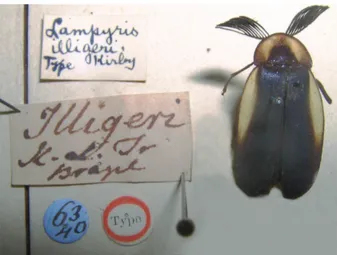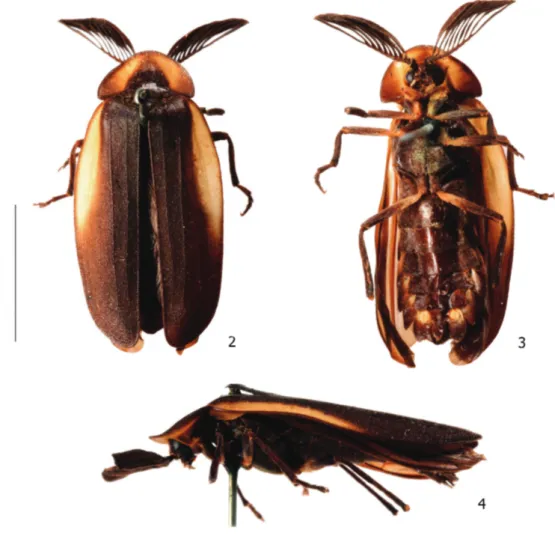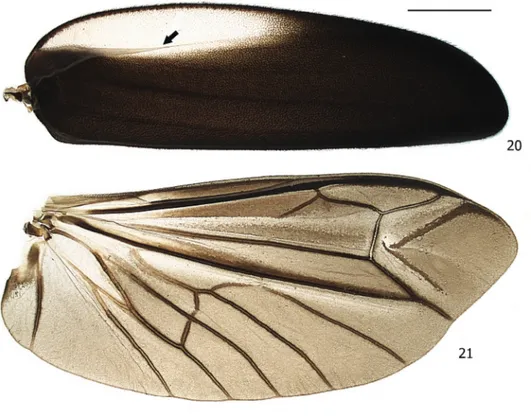DOI: 10.1590/1678-476620151053359366
Taxonomy of the Brazilian firefly
Cladodes illigeri
(Coleoptera,
Lampyridae): morphology and new records
Luiz Felipe Lima da Silveira1,2, Milada Bocakova3 & José Ricardo M. Mermudes2
1. Programa de Pós-Graduação em Ecologia, Laboratório de Ecologia de Insetos, Departamento de Ecologia, Instituto de Biologia, Universidade Federal do Rio de Janeiro, A0-113, Bloco A, Av. Carlos Chagas Filho, 373, Ilha do Fundão, Rio de Janeiro, RJ, Brazil. (silveira.lfl@gmail.com)
2. Laboratório de Entomologia, Departamento de Zoologia, Instituto de Biologia, Universidade Federal do Rio de Janeiro, A1-107, Bloco A, Av. Carlos Chagas Filho, 373, Ilha do Fundão, Rio de Janeiro, RJ, Brazil.
3. Department of Biology, Faculty of Education, Palacký University, Zizkovo nam. 5, CZ-77140 Olomouc, Czech Republic.
ABSTRACT. Cladodes illigeri (Kirby, 1818) is redescribed, and can be distinguished by the following features: color pattern overall black, paired spots and elytral margins pale yellow; pygidium bisinuate, posterior angles rounded, as long as median margin; and aedeagus with phallus 1/3 shorter than the parameres, which are sinuated apically. Cladodes lamellicornis (Motschulsky, 1854) is proposed as a junior synomym of C. illigeri. New records from the Atlantic Rainforest and illustrations for structural features are provided.
KEYWORDS. Amydetinae, Vestina, Neotropical, synonymy.
RESUMO. Taxonomia de Cladodes illigeri (Coleoptera, Lampyridae): morfologia e novos registros. Cladodes illigeri (Kirby, 1818) é redescrito, o qual pode ser diagnosticado pelos seguintes caracteres: padrão do colorido negro, com par de faixas amarelo-pálidas nas margens elitrais; pigídio bisinuoso, ângulos posteriores arredondados, tão longo quanto a margem mediana; e edeago com falo 1/3 mais curto que os parâmeros, os quais são sinuosos apicalmente. Cladodes lamellicornis (Motschulsky, 1854) é sinonimizado com C. illigeri. Novos registros da Mata Atlântica e ilustrações das características estruturais são fornecidos.
PALAVRAS-CHAVE. Amydetinae, Vestina, Neotropical, sinonímia.
Cladodes Solier, 1849 (Amydetinae, Vestina) are
small to very large-sized diurnal fireflies, distributed in
South America (McDermott, 1964), which share the following common characters: an outline narrowly to broadly elliptic; antennae 11-jointed, flabellate and sometimes fan-folded, shorter than body half, antennomeres
short, flabellae very long; eyes mediocre; elytra widest
at, ahead of, or posterior to midlenght; abdomen strongly lobed; terminal sternum with a median triangular point; male luminous organs rudimentary. The genus has 21 species (McDermott, 1966) in two subgenera: Cladodes s. str., and Fenestratocladodes Pic, 1935, monotypic. The genus still lacks taxonomic revision, and this study is
the first attempt towards it. In this paper, we present a
redescription of Cladodes illigeri (Kirby, 1818) based on study of holotype, and provide illustrations of structural features.
MATERIAL AND METHODS
Dissection techniques and terminology follows Silveira & Mermudes (2013, 2014a,b). We dissected and boiled in 10% KOH the specimens. Wing and abdominal sclerites were mounted under glass before illustration. The material was analyzed under stereomicroscope and photographs were made with the Leica Application Suite CV3 Auto-montage Software. Photographs were adjusted in Adobe Photoshop CS5 software. Specimens studied belong to the following collections: The National History Museum, London, United Kingdom (BMNH), Muséum National
d’Histoire Naturelle, Paris, France (MNHN), Zoological Museum of the Lomonosov, University of Moscow, Russia (ZMLM), Museu Nacional, Rio de Janeiro, Brazil (MNRJ) and Coleção Entomológica Prof. José Alfredo
Pinheiro Dutra, Rio de Janeiro, Brazil (DZRJ). Diagnosis
was provided based on the comparison with co-generic species compared with type-material whenever possible.
RESULTS
Cladodes illigeri (Kirby, 1818)
(Figs 1-32)
Lampyris illigeri Kirby, 1818:387
Megalophthalmus (?) illigeriMotschulsky, 1854:25
LucernutailligeriOlivier, 1911:65
CladodesilligeriMcDermott, 1966: 82
Nyctocrepis lamellicornis Motschulsky, 1854:10; Lacordaire, 1857:314; Olivier, 1885:139; Gorham, 1880:7 Syn. nov.
Cladodeslamellicornis McDermott, 1966:82.
Diagnosis.Colour pattern: body overall dark brown, pronotum black, with paired lateral pale yellow vittae, elytra black, basal 1/2 of lateral margins pale yellow, abdominal
sternum VIII with 1/3 lateral translucent, rudimentary larval
SILVEIRAet al.
360
symmetric, widest in the basal 2/5, then tapering to distal third, distal portion sinuate and projected internally; phallus 1/3 shorter than the parameres, constricted subapically, ventrodistally clefted, dorsoventrally membranous in apical 1/4; endophallus projected beyond the phallus.
Redescription, male. Body overall dark brown. Pronotum black with paired lateral pale yellow vittae. Elytra black, basal 1/2 of lateral margins pale yellow. Abdominal
sternum VIII with 1/3 lateral translucent, rudimentary larval
lanterns conspicuous. Pygidium black with anterolateral vittae. Trochanters and basal 1/4-1/3 of femora pale yellow. Body shape elliptic (Figs 1, 2). Head(Figs 1−13)
completely covered by pronotum (Figs 3−4), 2x wider than long. Eye (Figs 5−9) as long as 3/5 head width in dorsal and
ventral view; 1/4 as wide as head width, almost as wide in dorsal as in ventral view; internal margin divergent posteriad in dorsal view, almost parallel ventrally; posteroventral margin slightly beveled in lateral view; posterior margin somewhat truncate in ventral view. Frons prominent. Vertex
(Figs 5−9) somewhat plane, with two discrete posterior parasagittal indentations. Antennal sockets (Figs 7−8)
elliptic, separated by 1/3 labral width; 1/3 longer than wide; antennifer process conspicuous. Antennae(Figs
1−4,12) 11-jointed, flabellate, scape constricted in basal 1/2, pedicel slightly wider than long, antennomeres III-XI increasingly longer towards apex, basal flabellae slightly longer than 1/2 antenna length, flabellae slightly decreasing in size towards apex, antenommere XI 5x longer than X. Frontoclypeus curved. Labrum rectangular, slightly
longer than wide, connate to frontoclypeus. Mandibles (Fig 13) abruptly arcuate almost right-angled, apex acute, tooth absent; external margin sparsely setose in basal 1/3; internal margin strongly sulcate, with a wisp of bristles, basally. Hypopharynx bilobed, with dense, minute bristles.
Maxillary palpus (Figs 5−6) 4-jointed, IV>III>II=I, palpomere IV securiform with internal margin rounded;
cardo weakly-sclerotized, posterior margins truncate, stipe triangular, well-sclerotized, lacinia with dense, minute
bristles. Labial palpus (Figs 5−6) 3-jointed, III>II=I, palpomere III securiform with internal margin straight;
praementum well-sclerotized and bristled, sagittally divided; mentum U-shaped sclerotized and bristled. Gular sutures divergent posteriad, lesser width as wide as cardo width; gular bar straight, as long as 1/2 cardo length, as wide as 1/2 cardo width. Occiput (Fig 9) oblong, 1/3 longer
than wide. Tentorium (Figs 10−11) long and slender, almost
as high as head high, projected internally on the half of its length, strongly curved backwards.
Thorax (Figs 14−24) with pronotum (Figs 14−15)
semicircular, almost 2x wider than long; posterior angles rounded, slightly projected posteriad; disc overall
trapezoidal, regularly, finely punctured, medially elevated,
anterior margin projected, recurved anteriad, posterior margin straight, lateral margins divergent posteriad and depressed; with a line of deep marginal punctures; expanded all over, expansions irregularly, deep punctured, punctures separated by less than puncture diameter, anterior and lateral expansions well-developed, as wide as 1/2 disc posterior margin, lateral expansions (Fig 16) rather straight in posterior view, posterior expansions short, discreetly bisinuate; 1/3 wider than elytra major width. Hypomeron (Fig 16) 2x longer than high, discreetly projected posteriad, anterior and posterior margins beveled, ventral margin somewhat emarginate. Prosternum (Fig 15) 8-9x wider than long, anterior margin curved, posterior margin projected, prosternal process wide, truncate, entirely bristled. Proendosternite (Fig 17) slender, slightly shorther than 3x distance between proendosternites. Mesoscutellum (Fig
22) bristled, finely punctured, posterior margin rounded.
Elytra (Fig 20) almost 2,75x longer than wide, widening up to basal 1/3, then narrowing towards apex, pubescent, secondary pubescence present, with four costae, plus the marginal one, epipleura distinct up to 1/2 elytra length, with a line of conspicuous punctures all over sutural and lateral margins. Hind wing (Fig 21) well-developed, radial cell well developed, 4x wider than long, almost reaching anterior margin, costal row of setae absent, ScP juxtaposed to RA up to basal 1/4 radial cell length, where they fuse with C; CuA2 and mp-cu crossveinpresent; RP + MP1+2 slightly shorter than R4, almost reaching distal margin; J absent. Allinotum (Figs 22) 1/4 wider than long, lateral margins slightly convergent posteriad, posterior margin emarginate;
prescutum (Figs 22−23) extending up to 1/2 metascutum
length; rounded area of scutum weakly sclerotized, posterior margin membranous; scutum-prescutal plate well-developed, sclerotized, extending ridges up to posterior margin; metascutellum glabrous; postnotal plate emarginate. Mesosternum (Fig 24) membranous anteriad, pointed posteriad. Metasternum (Fig 24) depressed by the mesocoxae, anterior medial keel absent; discrimen almost as long as 2/5 sternum length; lateral margins enlarging towards lateral-most part of metacoxa, then convergent posteriad; with a pair of parasagittal indentations. Mesosternum/ mesanepisternum suture indistinct. Mesanepisternum/ mesepimeron suture conspicuous. Mesepimeron attachment to metasternum membranous. Mesendosternum with two parasagittal projections, irregularly allate, turned outwards.
Figs 2-4. Cladodes illigeri (Kirby, 1818): 2, dorsal; 3, ventral; 4, lateral habitus. Scale bar: 10 mm.
Metendosternum spatulate, projected and acute anteriad, with two lateral laminae, of the same width in anterior and posterior half. Trochantins sparsely setose in pro and mesolegs; protrochantin as wide as 1/2 procoxal width, touching procoxa medially; mesotrochantin as wide as 2/3 mesocoxal width, touching mesocoxa at internal 1/3. Procoxae tapering distally. Trochanters discreetly divided. Femur as long as tibia in pro and mesolegs; tibia slightly
longer than femur in metaleg. Tarsi I>V>IV>II>III; II bilobed, dense and finely bristled, lobes as long as 2/3
V lenght.
Abdomen (Figs 25−32) with sterna II-IX visible.
Spiracles dorsal in anterior 1/3. Abdominal tergum (Fig
25) I with anterior margin membranous, laterotergite
well-developed, internally projected; spiracle obliquely attached to thorax, more horizontally. Abdominal terga (Fig 25)
II-XII with acute posterior angles projected posteriad,
increasingly arcuate posteriad. Abdominal sternum (Fig 26)
VII slightly projected medio-distally, projection discreetly emarginate; VIII projected posteriad in median 1/3, slightly
longer than posterolateral margins. Pygidium (Fig 27) with lateral and posterior margins rounded, lateral angles
projected posteriad, acute, as long as posterior margin.
Syntergite (Figs 28−29) slightly shorter than abdominal sternite IX, acuminate posteriad, emarginate anteriad,
median suture conspicuous, symmetric, with median cross
membranous. Abdominal sternite IX assymetric, setose in
posterior 1/2, left margin slightly beveled. Aedeagus (Figs
30−32) well-sclerotized, phallobase symmetric, projected
dorsally; paramerae symmetric, widest in basal 2/5, then tapering to distal third, distal portion sinuate and projected internally, 1/3 shorter than phallus; phallus constricted subapically, ventrodistally clefted, dorsoventrally membranous in apical 1/4; endophallus projected beyond phallus.
Biology. Diurnal species, active especially on hot, moist days, abundant in moist broadleaf forests. They fly
heavily, relatively slowly, all-day long, up to dusk. Female and immature stages remain unknown.
Remarks. Lampyris illigeri was described by Rev. William Kirby, an English priest of the Anglican church, co-founder of the Linnean Society and a fellow of the Royal
Society of London for Improving Natural Knowledge. He
SILVEIRAet al.
362
in Entomologia heu desideratissimi, D. Illigeri, Borussi”, which means that the name is in honor to the prussian
entomologist, D. Illiger. Later on, Ernst Olivier placed the
species in Lucernuta Laporte, 1833. Viktor Motschulsky placed the species in Megalophthalmus Gray (=Magnoculus McDermott, 1964). Then, McDermott (1966) finally
placed the species in Cladodes Solier, 1849.
Based on study of the types, we propose Cladodes lamellicornis (Motschulsky, 1854) to be junior synonym of Cladodes illigeri (Kirby, 1818), which has precedence.
We also dissected genitalia of at least two specimens
from three different areas (Serra dos Órgãos and Serra do
Mar ranges, and Tijuca Forest), to account for phenotypic cohesion among populations, as an operational criterion of species delimitation (Sites & Marshall, 2004; De
Queiroz, 2007).
Type-Material. Holotype (Fig. 1): BRAZIL,
without other provenance data (BMNH). Labels: Lampyris illigeri Type Kirby (handwritten); Illigeri K. L. Jr Brazil
(handwritten); 6340 (handwritten); Type (typewritten). Lectotype of Nyctocrepis lamellicornis Motsch., male
(ZMLM), “Brasil”, without other data.
Material-examined, pinned. BRAZIL, Minas Gerais: ♂, Mar de Hespanha, 27.VIII.1908, J. F. Zilán col. (MNRJ); Rio de Janeiro:
♂, Rio de Janeiro (Tijuca) without other data. (MNRJ); ♂, (E[strada] das Paineiras), 22.XII.1996, A. Pimenta col. (MNRJ); idem locality
and date, J. R. I. Ribeiro, col.; ♂, (P. N. Floresta da Tijuca, Açude da Solidão), 02.X.1959, Newton Santos col. (MNRJ); ♂, (Corcovado), XII.1957, Alvarenga & Seabra, col. (MNRJ); ♂, (Bom Retiro), 08.01.1957,
Newton Santos col. (MNRJ); Santa Catarina: 2♂, without other data,
Cladodes lamellicornis, det. Olivier (MNHN). Alcoholed. BRAZIL:
Minas Gerais: ♂, (Itamonte, Parque Nacional do Itatiaia, Aiuruoca), 24.XI.2011, Silveira & Ávila col. (DZRJ); Rio de Janeiro: ♂, Nova Friburgo (Rio Cascatinha), 22-23.X.2011, Takiya, Santos Souza & Cruz col. (DZRJ); ♂, Rio de Janeiro (Estrada Pedra Branca/ Pau da Fome), XI.2001 R. Baptista col. (DZRJ); 2♂, Teresópolis (PAR[que] NA[cional da] S[erra dos] O[rgãos]), 12.XII.2010, Silveira col. (DZRJ); São Paulo:
2♂, Ubatuba (Parque Estadual da Serra do Mar, Picinguaba, Praia da Fazenda), 27.VI.2013, E. Matos col. (DZRJ).
Distribution.Known from Southeastern Brazil. Mar de Hespanha municipality is the northern-most distribution, and Ubatuba municipality (in the Serra do Mar range) southwestern-most distribution.
SILVEIRAet al.
364
Figs 20-24. Cladodes illigeri (Kirby, 1818). 20, Elytra ventral view (arrow shows elytral ventral line); 21, wing. Pterothorax: 22, dorsal; 23, lateral; 24, ventral. Scale bars 20-21: 2 mm, 22-24: 1 mm.
DISCUSSION
Currently, Cladodes is the second largest genus
of fireflies in the subtribe Vestina. The type genus Vesta
Laporte, 1833 has south-east Asiatic and south-American distribution, whilst other genera of the subtribe (Cladodes,
Ledocas Olivier, 1885, Dodacles Olivier, 1885, and
Dryptelytra Laporte, 1833) are exclusively Neotropical. While Asiatic fireflies have recently been studied (Sagegami-Oba et al., 2007; Bocakova et al., 2007),
phylogenetic relationships of South-American fireflies
are still ambiguous, both at the generic and the species level. This is also true for Cladodes, where the majority of the species is known only from the type specimens. Within Cladodes, only two subgenera (Cladodes s. str.
and Fenestratocladodes) are currently recognized, while our preliminary research (L. F. L da Silveira et al., in
prep.) indicated at least three different lineages of Brazilian Cladodes. Therefore, further research will be necessary to elucidate phylogenetic relationships among Neotropical
fireflies. After a detailed study of Amydetes Hoffmansegg,
Figs 25-26. Cladodes illigeri (Kirby, 1818). Abdomen: 25, terga II-VII and pygidium; 26, sterna II-VII (arrows point the spiraculae). Scale bar: 2 mm.
SILVEIRAet al.
366
another contribution on lampyrid systematics providing detailed morphological descriptions for Cladodes illigeri, one of the most common Brazilian species in the genus.
Acknowledgements. We would like to thank to M. Barclay (BMNH) and A. Taghavian (MNHN) for providing the material in their
charge; Mr. Steven Morris for revising the English; Dr. Ricardo Monteiro and Dr. Margarete Macedo, for allowing the use of the photographic equipment acquired by INCT Hympar Sudeste. This study has been
supported by grants from CNPq (process 470980/2011-7), FAPERJ (process 101.476/2010), CZ.1.07/2.3.00/20.0166 from European Social Fund and the Ministry of Education of the Czech Republic.
REFERENCES
Bocakova, M.; Bocak, L.; Hunt, T.; Teraväinen, M. & Vogler, A. P. 2007. Molecular phylogenetics of Elateriformia (Coleoptera): evolution of bioluminiscence and neoteny. Cladistics 23:477-496.
De Queiroz, K. 2007. Species Concepts and Species Delimitation. Systematic Biology56(6):879-886.
Gorham, H. S. 1880. I. Materials for a revision of the Lampyridae. Transactions of the Entomological Society of London1880:1-36.
Kirby, W. 1818 A Century of Insects, including several new Genera
described from his Cabinet. Transactions of the Linnean Society of London 12(2):347:453.
Lacordaire, J. T. 1857. Histoire naturelle des insectes. Genera des Coléoptères ou exposé méthodique et critique de tous les genres proposés jusqu’ici dans cet ordre d’insectes,. Lampyrides. IV + atlas: Malacodermes. Paris, Librairie Encyclopédique de Roret, p. 285-377.
McDermott, F. A. 1964. The taxonomy of the Lampyridae (Coleoptera).
Transactions of the American Entomological Society 90:1-72. _____. 1966. Pars 9. 2ed. Lampyridae. In: Steel, W.O. ed. Coleopterorum
Catalogus Supplementa. W. Junk, s’Gravenhage. 149p.
Motschulsky, V. de. 1854. Lampyrides. Études EntomologiquesII :1-14, 25, 33-43.
Olivier, E. 1885. Études sur les Lampyrides. Annales de la Société Entomologique de France 6(5):125-154.
_____. 1911. Révision des Lampyrides. Revue Scientifique du Bourbon
24:20-85.
Sagegami-Oba, R.; Takahashi, N. & Oba, Y. 2007. The evolutionary process of bioluminescence and aposematism in cantharoid beetles (Coleoptera: Elateroidea) inferred by the analysis of 18S ribosomal
DNA. Gene 400 (1-2):104-113.
Silveira, L. F. L. & Mermudes, J. R. M. 2013. Memoan ciceroi gen. et
sp. nov., a remarkable new firefly genus and species from the Atlantic
Rainforest (Coleoptera: Lampyridae). Zootaxa 3640(1):79-87. _____. 2014a. Systematic review of the firefly genus Amydetes Illiger,
1807 (Coleoptera: Lampyridae), with description of 13 new species.
Zootaxa 3765(3):201-248.
_____. 2014b. Ybytyramoan, a new genus of fireflies (Coleoptera: Lampyridae, Lampyrinae, Photinini) endemic to the Brazilian Atlantic Rainforest, with description of three new species. Zootaxa 3835(3):325-337.
Sites Jr, J. W. & Marshall, J. C. 2004. Operational Criteria For
Delimiting Species. Annual Review of Ecology Evolution and Systematics 35:199-227.





